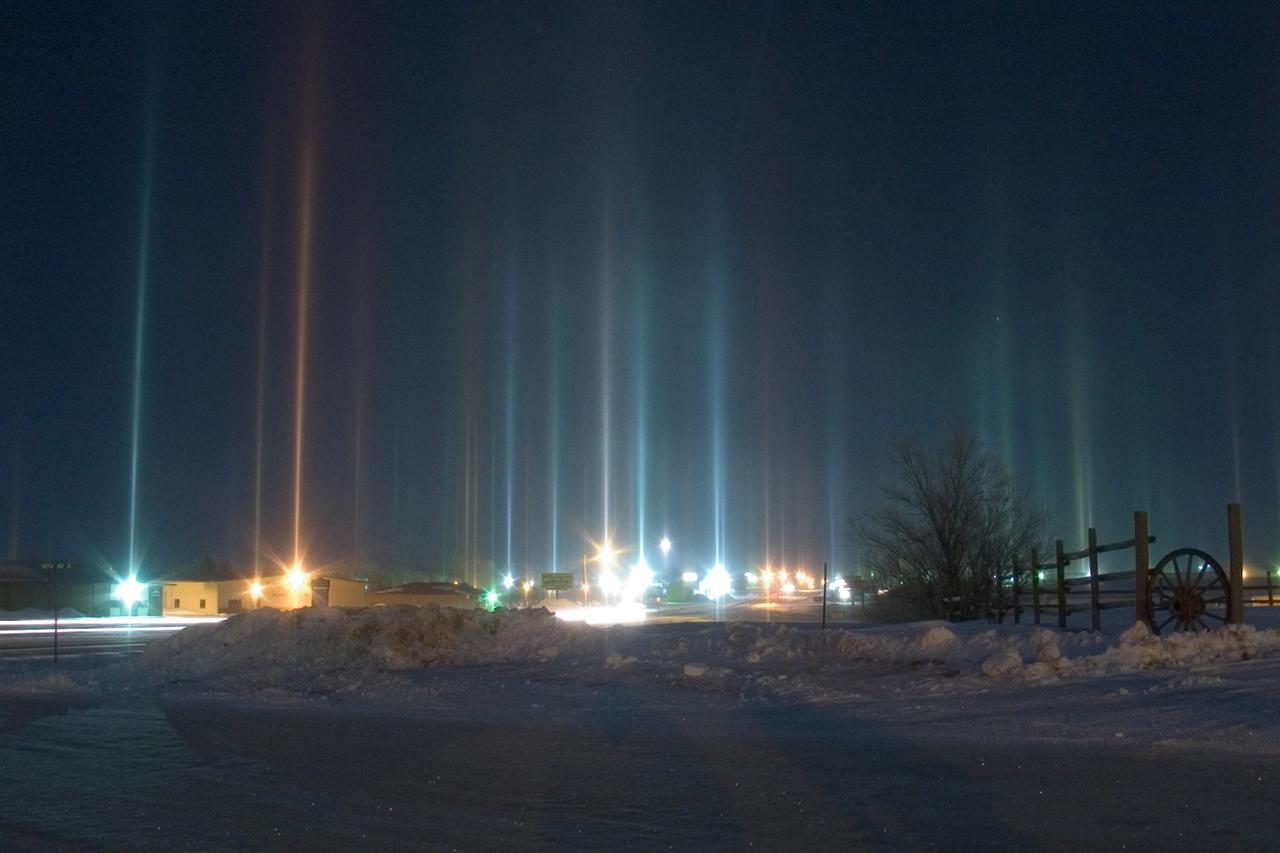Who created the magical light pillar?
2023-12-14

Light pillar is an ice halo phenomenon caused by the reflection of light from ice crystals in the atmosphere. Under the reflection mechanism of ice crystals, city street lights, neon lights, and car headlights turn into colorful light pillars that reach into the sky.
Nature is like a magical magician, surprising and shocking us from time to time. The magical light pillar celestial phenomenon is a visual feast given to us by nature.
The scientific principle behind the light pillar celestial phenomenon is not complicated. Simply put, it is the phenomenon of specular reflection of light. How did light pillar come about? What elements are needed to form this strange celestial phenomenon, and what roles do they play?
In the process of producing light pillars, ice crystals play a decisive role: the ice crystals arranged in the atmosphere are like layers of stage curtains, blocking the ground and the night sky, becoming the "curtain" of the ground lights.
We know that the air contains a large amount of water vapor, which condenses into water droplets; if the water vapor sublimates, it turns into ice crystals. Sublimation is a weather phenomenon that easily occurs in cold areas: too low temperatures cause water vapor in the atmosphere to freeze, forming tiny ice crystals. In life, the clouds that we can recognize with the naked eye contain a large number of water droplets and ice crystals.
So, can we see the light pillar with ice crystals? of course not. Because not all ice crystals contribute to the appearance of light pillars. There are two main types of ice crystals in the atmosphere: columnar ice crystals (columnar crystals) and flaky ice crystals (lamellae crystals). Both types of ice crystals are hexagonal prisms. In addition, there are rare pyramidal ice crystals (cone crystals) and special-shaped ice crystals (isocrystals). Among them, flaky ice crystals make the greatest contribution to the light pillar phenomenon.
Flake ice crystals are produced in environments where the air is very cold and the structure of the lower atmosphere is fairly stable. Its formation is generally affected by factors such as air temperature and humidity. If there are a large number of horizontally arranged flake ice crystals suspended in the night sky and there is no wind in the sky, these ice crystals will float in the air like miniature mirrors. At this time, in the vertical direction of the atmosphere, various types of lights are reflected and refracted by flaky ice crystals at different heights, and finally gather into pillars of light. This is the light pillar we see.
Meteorological monitoring shows that when the temperature is between -20 and -10°C, ice crystals and water droplets coexist, which is most beneficial to the formation of flaky ice crystals. Starting from the -10°C isotherm, ice crystals generally increase gradually as the height increases. Especially before and after snowfall, the drop in temperature and increase in air humidity are very conducive to the formation of ice crystals.
In addition to ice crystals, the main contributors to light pillars include artificial light sources; otherwise, even if the ice crystals form a "curtain" between heaven and earth, the light pillar cannot be produced due to the lack of irradiation light sources.
This has the same principle as the formation of a rainbow; the difference is that the rainbow reflects the sun's rays, and in the formation of the light pillar, artificial light sources make the greatest contribution. In rainless weather, these artificial light sources are primitive point lights to the human eye; on rainy days, due to the reflection and refraction of raindrops, what we see is linear or multi-dimensional ray-like beams.
There are many ground light sources that can be reflected on ice crystals, such as ground spotlights, bright street lights, searchlights, neon lights, etc. in the city. In October 2022, a light pillar phenomenon occurred in Jeju Island, South Korea. According to analysis by the local meteorological agency, the light pillar was caused by the reflection of lights from fishing boats operating offshore Jeju Island. In 2022, a light pillar phenomenon also occurred in Xilinhot City, Inner Mongolia, my country. The emergence of the light pillar phenomenon is related to local lighting. Normally, the color of the light pillar will be the same as the color of the light on the ground.
With the light source and ice crystal "curtain", the magical light pillar requires another important participant, which is the meteorological element.
Temperature is the most important factor. Because ice crystals need to be formed under lower weather conditions, especially when the temperature is below -20°C, it is most beneficial to the formation of ice crystals; however, the lower the temperature, the better, because when the temperature is too low, it is easy to form prisms. Ice crystals are not conducive to vertical reflection of light.
Another important meteorological factor is wind speed. The mass of ice crystals is very small, especially flake ice crystals. If the wind speed is too high, the ice crystals will swing violently with the wind and will not easily become a complete quasi-mirror. We will not be able to see the wonder of the straight up and down "lamp poles". Meteorological workers analyzed the winter light pillar phenomenon in Xilinhot City in 2015 and found that within 4 hours of the phenomenon occurring, Xilinhot City was mostly in a breeze period with a wind speed of 2 meters per second. This means that if you want to see the light pillar, you can only see it in light or calm weather conditions.
Even if the above conditions are met, it does not mean that light pillar will definitely appear. High relative humidity, no obvious clouds and fog at low altitude, cooling, snowfall... are also factors that affect the light pillar phenomenon. This is also an important reason why most light pillars occur at night before and after snowfall in alpine areas and when the weather is clearer.


